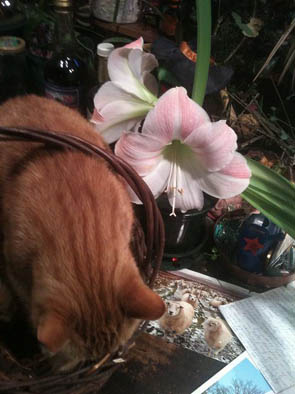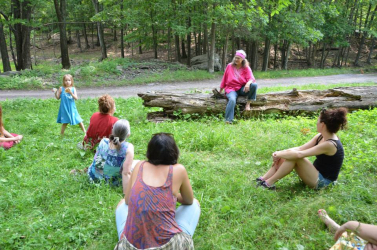
And here come the plants! (Again, as always.)
Look, the snowdrops are blooming. (Actually, they were blooming last month for my birthday, but I only caught a quick glimpse of them before they were buried by snow and so I didn't get a photo for you until today.)
Time to take off your shoes and go for your first barefoot walk of the year. (Even if you only take three steps; do it!)
This week we are continuing to explore one of my favorite herbs (and one of the safest herbs in the world to use): Grandmother Slippery Elm. If you haven't already tried the oatmeal cooked with slippery elm from last week, here's another chance to change forever how you eat your oats. (And if you did try my "value-added" oatmeal, let us know how you liked it.)
I know you thoroughly enjoyed watching my granddaughter Monica Jean
make slippery elm balls. Have you (and the children in your life) made some too? If not, now you have another chance. Make the time to make this sovereign remedy. And take it with you where ever you go.
I never leave home without my slippery elm balls. They are there for me and for anyone I meet along the way who needs a nourishing, soothing, healing herb. (That is all of us at one time or another, isn't it?) Acid indigestion flees. Sore throats are banished. Bladder is happy. Guts are relaxed. Oh yes, we all need some slippery elm.
Since slippery elm is native to the northeastern parts of North America, it is not found in the classic herbals of the European and Russian traditions. But both the Native Americans and the New Americans used it extensively, for food, medicine, cordage, bandages, and more.
Ancient fabrics found in Ohio, dated to around 300 BCE, were made of slippery elm bark.
This is one fascinating tree.
1755, James Smith: "In this month [February] we began to make sugar. As some of the elm bark strips at this season, the women, after finding a tree that will do, cut it down. With a crooked stick, broad and sharp at the end, they took the bark off the trees, and of this bark made vessels that would hold about two gallons each. They made above one hundred of these. They also made bark vessels for carrying the maple water that would hold about four gallons each. . . . . They made the frost, in some measure, supply the place of fire, in making the sugar. Their large bark vessels, for holding the maple water, they made broad and shallow. The maple water freezes at night and the ice they break and cast out of the vessels. I observed that after several times freezing, the maple water that remained in the vessel changed in color and became brown and very sweet." (from
Use of Plants for the Past 500 Years, Charlotte Erichsen-Brown, Breezy Creeks, 1979)
7871, J. Shoepf,
Materia Medica Americana
"Salve bark" is used to treat skin ulcers, abscesses, inflammations, burns, chilblains, boils, broken bones, syphilitic eruptions, and leprosy.
1859, Gunn
"It is so important an article that it may be had at almost any drugstore now in finely ground powder. . . ."
1931, Maude Grieve,
A Modern Herbal
"The bark of the American Elm...is considered on of the most valuable remedies in herbal practice, the abundant mucilage it contains having wonderfully strengthening and healing qualities. It. . . has a most soothing and healing action...[and] in addition possesses as much nutrition as. . . oatmeal. . ."
1968, Henrietta Rau,
Healing with Herbs
"Red elm is one of the finest and most valuable remedies in the herbal world and should be in every home; there is nothing in this world to equal it. . . ."
1969, Alma Hutchens,
Indian Herbalogy of North America
". . .will sustain ulcerated and cancerous stomach [and bowels] when nothing else will."
1976, Dr. Christopher,
School of Natural Healing
"Slippery elm is one of the most valuable medicines in the herbal world."
1977, John Heinerman, Herbal Medicines
"As a poultice, there is, perhaps, nothing within the bounds of medical knowledge equal to the Slippery Elm bark."
2006, Steven Foster and Rebecca Johnson,
Desk Reference to Nature's Medicine,
"The U.S. Food and Drug Administration recognizes slippery elm as a safe and effective option for sore throat and cough." "Slippery elm is one of four main ingredients in two of the most widely used herbal cancer treatments. . . ."
2010, Steven Foster, Rebecca Johnson; Tieraona Low Dog MD, and David Kiefer MD,
National Geographic Guide to Medicinal Herbs
"Slippery elm is generally well tolerated. But it is not recommended for those with bile duct obstruction or gallstones." "Other drugs should be taken one hour prior to or several hours after consumption of slippery elm, as it may slow the absorption of oral medications."
"Beware of slippery elm respiratory formulas in capsules or tablets to be swallowed as this negates any demulcent action on the throat."
Undated "
Here is a rare delight. How good
A medicine that is also food
For he who nothing takes besides
For many days is well supplied."
Attributed to Christmas Humphreys

Greetings to all!
May the breezes of spring open your heart to another season, another cycle, another year of green blessings.
Thank you all so much for your enthusiastic response to my new mentorship site. I feel so privileged to be allowed to help you find your way in herbalism. There are so many paths and so many opportunities, and so many ways to wander into a path that isn't really the best for you when sharing the green. "The mentor's hindsight is the student's foresight," a recent fortune cookie told me. May my many mistakes pave the way for your success.
When my mom died, I noticed that I could no longer call her with my good news. In her honor, I have endeavored to become that glad heart for others. That someone you can feel comfortable with while enjoying sharing your good luck and your accomplishments. May my delight in your growth nourish you.
As we move into the growing and harvesting seasons, I continue to work in the storeroom, making room. Thus comes the question: "How long can I store herbs?" Or "How long will herbs stay good?"
The answer is, of course, "That depends."
I am continually surprised at the longevity of the herbs I harvest. Dried nettle ten years old still infuses with bright green color and rich deep taste. Red clover blossoms dried five years old are still wonderfully scented and brightly hued. Cronewort harvested twenty years ago fills the room with her scent and tastes reliably bitter.
That depends on:
1. The weather when the herb was harvested.
2. How the plant was grown.
3. How the herb was harvested.
4. How the herb was dried.
5. How the herb was stored.
6. How the herb was prepared before and after storage
I will discuss each of these variables in further detail on the very next page, where you will also find a new slippery elm recipe. Mentorship students will continue their studies of slippery elm throughout this week with lots more slippery elm recipes and info and will find a much longer discussion of the topic of herb longevity in their special ezine pages.
Wishing you all spring green blessings.
Susun

 The Wise Woman Center exists to re-weave the healing cloak of the Ancients. This land is sacred, it is a safe space for women, and a place for the teachings of the Wise Woman way. The Goddess lives here, as do goats, fairies, green witches, and elders.
The Wise Woman Center exists to re-weave the healing cloak of the Ancients. This land is sacred, it is a safe space for women, and a place for the teachings of the Wise Woman way. The Goddess lives here, as do goats, fairies, green witches, and elders. And here come the plants! (Again, as always.)
And here come the plants! (Again, as always.)
